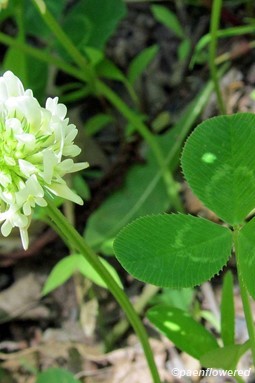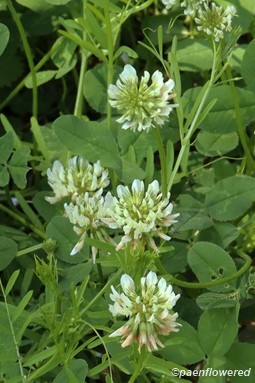Trifolium repens
Trifolium repens white clover
You don’t have to go further than your yard to see this flower, often in abundance. The white clover is a perennial plant native to Europe, North Africa and Western Asia, but was imported to the United States as a forage crop for animals. It has leaves that have the typical 3 leaflets of the clovers, but also has a V-shaped marking on each leaflet. The plant spreads from horizontal runners, often forming spreading clusters. The ¾-inch globular flower clusters may contain 20-50 white pea-like tubular flowers often tinged with pink. These flowers turn brown and papery with age, but the plant continues to bloom from May through October.
White clover is a legume and makes nitrate fertilizer from the atmosphere. Therefore it does well in almost any soil and is commonly found in lawns, fields, and roadsides throughout the country. Those who believe that a yard should only consist of grass consider the white clover a weed. It may also attract bees that may occasionally sting those who like to walk on their lawns in bare feet.
The fruit is a pod containing 3-4 seeds. The pods and seeds can be ground to make a type of flour. The flower attracts a variety of bees and butterflies as pollinators and the plant is eaten by a variety of local mammals. The fruit is a pod containing 3-4 seeds. White clover is also nutritious to livestock as it is high in protein. It has been used, primarily as a tea, in folk medicine. The clover can be eaten raw as a survival food and was often used this way in Ireland and Scotland. Sometimes the plant produces an extra leaflet—the “lucky” four-leafed clover. It is sometimes called Dutch clover and also incorrectly a shamrock. White clover blooms continuously from June until September.
Habitat & Range
Common in lawns, fields, and along roadsides.
Present throughout the state.
| EMP: | FACU |
|---|---|
| NCNE: | FACU |
Phenology
Flowers May through October.










Comments
Have you spotted this plant in your area? We'd love to hear about your experience! Share your comments or questions about the plant below. Comments are moderated before posting.